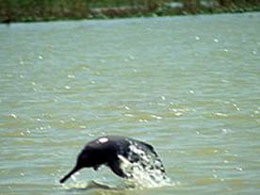 The areas bordering national parks and reserves are usually rich in natural flora and fauna. The abuse of the biodiversity is also greatest in these areas as they do not fall under any protection frame. But now the forest department is trying to map the land use pattern within a radius of 10 km around national parks so as to protect these biodiversity areas and ecological corridor links.
The areas bordering national parks and reserves are usually rich in natural flora and fauna. The abuse of the biodiversity is also greatest in these areas as they do not fall under any protection frame. But now the forest department is trying to map the land use pattern within a radius of 10 km around national parks so as to protect these biodiversity areas and ecological corridor links.
With the help of NGOs and other organizations, the forest department has set to the task of mapping the eco-sensitive zones (ESZ) around sanctuaries and national parks. Several protected areas have roads, hotels and resorts, industries, mining, and the close proximity of these areas to the parks and sanctuaries have impacted the environment.
The Supreme Court had recently directed state governments to forward proposals for ESZ to the ministry of environment and forests (MoEF). Once declared, developmental activities in these zones will be regulated and the existing infrastructure projects will be under scanner.
According to the ministry these new zones will act as shock absorbers or transition regions from the highly protected parks and sanctuaries to the lesser protected zones. The infrastructural development too can then be allocated in such a way that the forest and its inhabitants are least affected.
The present task of the forest officials is to take stock of the agricultural and industrial practices around the reserve areas. Once completed though, the industries will not be prohibited to function but their activities will be more severely regulated.
Chief conservator of forests, Pune, Nitin Kakodkar said, “We will look into the existing development plan as well the proposed activities. The regulation or prohibition of activities in these areas will be based on the importance of biodiversity. Activities in the eco-sensitive zones would be regulatory rather than prohibitive. There will be regulations and prohibitions on various activities, such as road construction, industry pollution, mining, felling of trees and, establishment of hotels and resorts.”
In an Eco-Sensitive Zone following are prohibited activities,
- Commercial mining
- Setting up of saw mills
- Commercial use of firewood
- Establishment of major hydroelectric projects
- Discharge of effluents and solid waste in natural water bodies or terrestrial area
- Use of production of any hazardous substances
Regulated activities,
- Felling of trees
- Establishment of hotels and resorts
- Widening of roads
- Use of polythene bags by shopkeepers
Permitted Activities,
- Ongoing agriculture and horticulture practices by local community
- Rainwater harvesting
- Organic farming
- Use of renewable energy sources
Experts are of the opinion that an ESZ for individual forests can be different and therefore the area can’t be standardized. It has to remain flexible. To make matters easier therefore, once the initial survey is done by state forest departments, the report will go the MoEF for draft notification. The ministry will put it up on public domain for suggestions and will come up with a final notification.
VB Sawarkar, former dean, the Wildlife Institute of India, said, “The idea of ESZ is to focus on conservation of species and maintain biological diversity that are outside the boundary of protected areas. Once declared ESZ, it will allow animals to use corridors and allow them to disperse. The idea is to reduce the impact of various activities in these areas. Emphasis will be given on conservation and education to create awareness.”
Declaration Dilemna
Although the move to have an eco-sensitive zone is a great one, it is not necessarily an easy task. There are several sanctuaries within India that are frequented by people because of the presence of sacred worship places within the boundaries of the sanctuary. Farming and farm lands, livestock grazing, horticultural use of the forest force humans to constantly be within the borders or inside protected areas.
On the other hand, there are some sanctuaries that have been created to protected endemic species such as the Sasan Gir national park which is the one and only bastion of the Asiatic lions. The protection of the area beyond the boundaries of the park is important here, as then it will secure the future of the endemic species.
Thus, different sanctuaries will present different set of challenges where people’s presence within the boundaries will have to be contained but cannot be entirely eradicated.
Jayant Kulkarni of Envirosearch an NGO that was asked for suggestion regarding the ESz says the organization ideated creation of different zones like riparian zones (habitat for birds and bees), lateritic plateaus (rich in biodiversity), cliffs (habitat for birds), importance to areas with indicator species like Indian Giant Squirrel in Bhimashankar, among others. The wildlife corridors between two sanctuaries (example Koyna and Chandoli) should be included as ESZ they suggested. The organization also said that forests on private land outside protected areas which are rich in biodiversity should be included in ESZ.
The ESZ is not meant to hamper day-to-day activities, but is meant to protect the precious forests or protected areas in their locality from any negative impact, and also to refine the environment around the protected areas. If done correctly, these zones can indeed function as the check posts where human activities are contained to save wildlife.
Related Stories:
Indo-Pak Border Dividing Animal Homes
Indian Scietists Plan to Create Virtual Fence to Save Forest Animals
Mini Hydel Project Threatening Biodiversity Hotpsot
Reference: TOI





